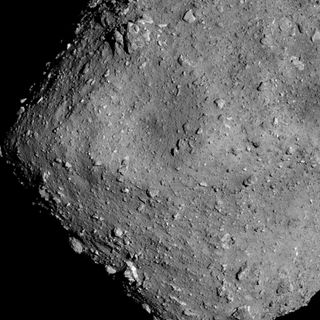Boulders and a Crater Dot Asteroid Ryugu in This Spectacular Up-Close View

A Japanese space probe orbiting an asteroid called Ryugu just took the closest photo yet of the diamond-shaped space rock.
The Hayabusa2 spacecraft launched to the asteroid Ryugu in December 2014 and arrived on June 27 of this year. The probe will study Ryugu up close for 18 months before returning to Earth with a sample of the asteroid in 2020. After Hayabusa2 entered into orbit around Ryugu, it began hovering at an average distance of about 12 miles (20 kilometers) away from the asteroid's surface, Japan Aerospace Exploration Agency (JAXA) officials said in a statement.
Last week, mission controllers began to lower the spacecraft's altitude to observe the asteroid's surface. Hayabusa2 captured this view of Ryugu when it was about 4 miles (6 km) away on July 20. [Japan's Hayabusa2 Asteroid Ryugu Sample-Return Mission in Pictures]
In the center of the image, you can see Ryugu's largest crater. "You can also see that the surface of Ryugu is covered with a large number of boulders," JAXA officials said. "This picture will provide important information as we choose the landing site."
Hayabusa2 spent only one day hovering so close to Ryugu. "After conducting observations of Ryugu during this time, Hayabusa2 began to ascend on July 21," after which it returned to its "home position" at an altitude of 12 miles (20 km), JAXA officials said.
During its time at Ryugu, Hayabusa2 will scoop up multiple samples from the asteroid and blow an artificial crater into its surface to study materials below the asteroid's surface. It will also deploy a lander called MASCOT and three small MINERVA-II rovers, which are based on similar rovers deployed by JAXA's first Hayabusa mission to asteroid Itokawa.
Email Hanneke Weitering at hweitering@space.com or follow her @hannekescience. Follow us @Spacedotcom, Facebook and Google+. Original article on Space.com.
Get the Space.com Newsletter
Breaking space news, the latest updates on rocket launches, skywatching events and more!
Join our Space Forums to keep talking space on the latest missions, night sky and more! And if you have a news tip, correction or comment, let us know at: community@space.com.

Hanneke Weitering is a multimedia journalist in the Pacific Northwest reporting on the future of aviation at FutureFlight.aero and Aviation International News and was previously the Editor for Spaceflight and Astronomy news here at Space.com. As an editor with over 10 years of experience in science journalism she has previously written for Scholastic Classroom Magazines, MedPage Today and The Joint Institute for Computational Sciences at Oak Ridge National Laboratory. After studying physics at the University of Tennessee in her hometown of Knoxville, she earned her graduate degree in Science, Health and Environmental Reporting (SHERP) from New York University. Hanneke joined the Space.com team in 2016 as a staff writer and producer, covering topics including spaceflight and astronomy. She currently lives in Seattle, home of the Space Needle, with her cat and two snakes. In her spare time, Hanneke enjoys exploring the Rocky Mountains, basking in nature and looking for dark skies to gaze at the cosmos.
